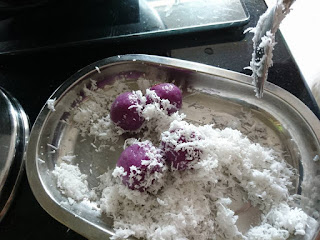If you are of Hakka descent, or one of your parents is, you may have seen this kuih before. The Chinese name for this plant is called AiCao or Aicai 艾草或艾菜). Its English name is Mugwort or Wormwood. Here I will not talk much about the benefits; you can google for more information.
Its slightly bitter in taste and has very strong herb aroma. Due to its unique taste, it is usually not very commonly accepted by people, especially the younger generation.
I hardly see people selling this kuih in the shop or market, let even the fresh aicao. Today I got the courage to make this because I wish to record this dish for my children. Come the day in the future when I am gone, if not for this blog post, nobody will remember what is "aicao ban"(艾草粄).
Note: 'ban' (粄) means kuih (dumpling) in Hakka.
Recipe:
Filling Ingredients:
(A)
500 g turnip
5 g black fungus (soaked, cut into trips)
15 g dried shrimps (soaked, drained and diced)
1 shallot (chopped)
1 pip garlic (chopped)
80 g minced pork
1 pc Chinese leek (washed and cut into 1/2 cm length)
(B) Seasoning:
1/2 tsp salt
1/2 tsp oyster sauce
1/2 tsp sugar
pepper
Method:
1)Skin off turnip, cut into thin strips or shredded
2) Heat 2 tablespoon of oil in a wok, saute dried shrimps for few minutes, then add shallots, garlic stir fry till fragrant. Add in minced pork, cook till the meat is cooked. Then add turnip, fungus and seasoning cook for a while. Add in seasoning (adapt and adjust to your taste bud) and leek, fry well. Dish up and leave to cool for later use.
Skin dough: (yields 20 pcs of dough 25 g each)
50 g fresh ai cao (mugwort)
50 g rice flour
200 g glutinous rice flour
1 tbsp oil
1/2 tbsp fine sugar
Method:
1) Pick only the young mugwort leaves , discard the old leaves and stems to get 50 g。Wash.
2) Bring to boil with water just enough to cover. Boil for about 10 to 15 minutes. Use a food processor to blend, drained and get the residue. Do not throw away the water.
3) Combine glutinous rice flour, rice flour, sugar and the mugwort residue and water to mix well till a pliable dough is formed. I forgot to weigh the water but do not worry. Gradually add water while you are mixing the dough till you get a pliable dough (not too wet).
4) Weigh the dough and take 10 % of the dough. Take the 10% small dough divide into 2 or 3 portions.Roll round and flatten, boil the dough in the water (boiled mugwort water from step 2), till it floats on the surface - this is your cooked dough. Take out and tear into pieces, add into the dough and knead till a smooth dough. Do not forget to add oil now and knead further for few minutes till you get a smooth and pliable dough. Cover and rest for 10 minutes.
(Adding in the cooked dough helps in your handling during wrapping of the dumpling. )
5) Scale dough into 25 g each. Roll into balls and use your palm or a rolling pin to flatten the dough like a round disc. Put a tablespoon of filling at the center, close the opening and seal properly. You may make into a dumpling shape (饺子jiaozi).
6) Place them on a greased tray (if you do not have banana leaf), steam over high heat for 15 minutes.
Serve.
Note: If the dough is too wet add more flour.
Photos
 |
| Ingredients for the filling, minced meat is not shown in the picture. Bean curd is optional. |
 |
| Boil mugwort for 10 to 15 minutes. Blend and strain to get the residue |
 |
| cooked dough |
 |
| Add cooked dough in the uncooked dough. Knead the dough till smooth and pliable |
 |
| Wrap up with filling, ready to steam |
 |
| Before (background) and after steaming (foreground) |
If you prefer, or you have leftover fillings, you can also make plain skin hakka dumplings without the aicao. :)
 |
| Made plain skin Hakka dumpling with the balance filling. |




































